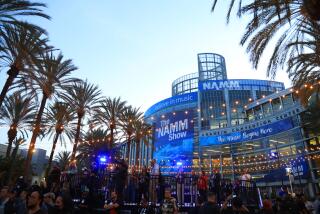Music Industry Plays to Age of Computers
- Share via
In the good old days, guitars went twang and drums went bam. Now, with the aid of computers, guitars can sound like drums, drums can sound like guitars, and ever the twang shall meet.
Whereas once they struggled alone, the music and computer equipment industries are learning to play--and profit--together.
Computers, in fact, are so vital to the $2.5-billion musical instrument industry that they do everything from teaching music to youngsters to helping composers streamline writing, said Larry R. Linkin, executive vice president of the National Assn. of Music Merchants.
Years ago, Linkin said, “you’d push a button and get one electric sound. Today, you can push a button and get thousands,” Linkin said Friday at the Carlsbad-based organization’s winter exhibition at the Anaheim Convention Center.
The computer influence has brought a resurgence to the musical instruments industry: After a two-year slide of nearly 20%, sales edged upward last year.
Music industry experts say the problems have been twofold: Not only has a declining birth rate hurt sales, but recession-induced budget cuts have continually whacked away at a key market for music merchants, school bands.
More than half of the 450 exhibitors offered some sort of computer-related gadgetry to the 21,000 attendees who purchased an estimated $200 million in musical equipment at the show. Musicians who once asked, “Where’s the disco?” were suddenly asking, “where’s the disk go?”
A musician who needs 500 different sounds for a song can now stand in front of a computer-assisted keyboard and get them all, said Tomczek Bednarek, director of marketing for Hybrid Arts, a Studio City company that sells musical hardware and software. “You can have the sound of wind blowing or an elephant screaming, both on the same keyboard,” he said. Sounds such as these can be put on computer chips, and a selected signal to the keyboard will automatically reproduce them.
The bottom line for music makers is savings aplenty. In many cases, a single performer can now make the music of an entire band. And for a $1,000 investment in a computer and keyboard, some musicians are finding that they can have recording-studio quality at home--saving them $150 an hour in recording-studio costs.
Yamaha International Corp., the Buena Park-based U.S. arm of Nippon Gakki Co., Ltd. of Japan, is regarded as one of the giants to combine computers with music. “We have reached the age where you can now compose, play back, listen and edit on your computer,” said Phillip Moon, Yamaha’s director of advertising.
What has made all this possible is an apparatus that those in the trade call MIDI (Musical Instrument Digital Interface). This communication device allows musical instruments and computers to be plugged into each other. It is a standard feature on most synthesizers and professional keyboards.
“It all broke loose about two years ago,” said Herb Nolan, editor of Up Beat, a Chicago-based music industry trade journal. “One person can now sit down in front of a keyboard and do things it once required an entire band to do.”
Were it not for the ongoing computer and electronics revolution in the music arena, many instrument manufacturers admit they might be playing their swan song. So far-reaching is the electronics factor that some manufacturers who for decades relied exclusively on acoustical sound are now going electric.
Martin Guitar Co., the Nazareth, Pa.-based company that has made acoustical guitars since 1833, recently overhauled much of its line to keep up with the demands of the ‘80s. A few years ago it began making electric guitars, and most recently it narrowed the wide necks on some acoustical guitars to feel more like electric guitars. “The computer and everything that spins off the computer is affecting today’s music,” said Dick DeWalt, Martin’s national sales manager.
Similarly, Deering Banjo Co. of Lemon Grove, Calif., one of the largest manufacturers of banjos in the U.S., introduced an electric banjo at the show. “In a matter of weeks, you’ll see these on MTV and Nashville Network,” said Janet Deering, co-owner of the company.
The electric banjos have bodies like guitars but faces like banjos and, at $780 apiece, cost about twice the price of traditional banjos. “We want to attract the teen market and bring the banjo into rock ‘n’ roll,” said Chuck Neitzel, a sales representative for the firm.
If banjos can go electric, why not drums? Electric drums, which look like hard rubber pads, are programed to reproduce a variety of near-perfect drum sounds when struck by the drummer. “To get this quality of sound on a regular drum would take hours and hours in a recording studio,” said a demonstrator for E-MU Systems, Inc., a Santa Cruz manufacturer of electric drums. A complete electric drum set costs about $2,400.
Terry Swanson, owner of Bo-Jangles Music in Laguna Beach, said that in order to stay competitive, he knows his store must stock more computer-related and electronic equipment. He planned to buy $25,000 worth at the show. “The problem is, every six months the technology changes,” he said.
More to Read
The biggest entertainment stories
Get our big stories about Hollywood, film, television, music, arts, culture and more right in your inbox as soon as they publish.
You may occasionally receive promotional content from the Los Angeles Times.










